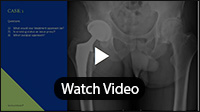Arthroplasty Cases That Teach Us the Most: 69 yo Male with Severe Degeneration of Bilateral Hips and Hip Arthritis
by Drs. James Germano, Zucker School of Medicine at Hofstra/Northwell, Hempstead, NY, Nicholas Yohe, South Shore University Hospital, Bay Shore, NY, Mike Bisogno, Northwell Health, Huntington, NY, Sreevathsa Boraiah, William Walsh, Northwell Health, Great Neck, NY, Luke Garbarino, Northwell Health, New Hyde Park, NY, Giles Scuderi, Northwell Health Orthopaedic Institute, Garden City, NYJoint Replacement Made Easier
High-tech surgeries, more durable implants, new ways to control pain: Orthopedic advances at Syosset Hospital are getting patients home faster. You hear you might need hip and knee replacement surgery and your first throught is ordeal ahead. And back in your parent's day, that might have been a fair assessment. In fact, untill recently, total joint replacement surgery meant up to a week in the hospital, plus more time in a rehabilitation center and in some cases, months of using a walker or curtches.
Genetic study explores the microbiome of hip and knee osteoarthritis
Next-generation DNA sequencing (NGS) techniques show the presence of bacterial DNA in surgical specimens of hip and knee arthritis, from patients undergoing first-time total joint arthroplasty, reports a study in the Journal of Bone and Joint Surgery.
Pain Relief After Total Knee Arthroplasty with Intravenous and Periarticular Corticosteroid
Total knee arthroplasty (TKA) is a cost-effective procedure, but it is also associated with substantial postoperative pain. The present study aimed to compare pain relief and functional recovery after TKA among groups that received intravenous corticosteroids, periarticular corticosteroids, or a combination of both.
Chondromalica: Causes, Risk Factors, and Prevention
Chondromalacia patella, also known as runner's knee, is a knee condition that can cause pain and grinding when the knee is flexed. It's due to the breakdown in the cartilage on the undersurface of the kneecap (patella) that causes bones to rub against each other. Overuse (especially from running or cycling), trauma, such as a fracture, or a misalignment of the kneecap and femur can all cause chondromalacia.
